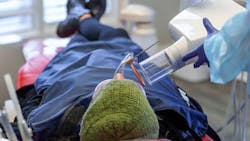In my experience, there are three common mistakes that clinicians experience in dental practices when taking x-rays. Are you or your team doing any of these, and if so, what can you do to correct your process?
No. 1: Distance
The mistake: A common mistake I see clinicians make is they position the x-ray head too far from the patient. Think of x-ray head generators like a shotgun—the farther you are away from the target, the more spread out the x-rays will be. This can cause images to be light due to the increase in the source-to-object distance from not placing the x-ray head close enough to the patient’s face during exposure.
How to resolve it: To fix this, ensure that your cone placement is consistently the same distance from the patient’s cheek for every shot. Try to get the x-ray tube as close to the skin as possible. When you need to aim at a larger angle to capture the apices of a maxillary molar, make sure you don’t move the cone too far away from the patient. Consistency with placement distance is the key to dependable image contrast.
You might also want to read:
3D tomosynthesis: The future of dental imaging allows you to see more, do more, and stress less
No. 2: Exposure
The mistake: Another common issue is underexposed x-rays that look too light and grainy. The most noticeable problem is the increased noise, which appears as grainy images with uneven patterns or streaks, hindering the clarity of specific details. Moreover, the radiographs appear excessively white or light when they’re underexposed, indicating that the x-ray beam did not penetrate the density of the patient’s anatomy.
Overexposure of the x-ray makes the images look too dark with blooming or cervical burnout. Burnout will be seen as black areas that creep into the teeth in the x-ray. Extreme cases can even hide entire teeth in the x-ray.
How to resolve it: Neither under- nor overexposed images can be properly fixed in the imaging software since the data was corrupted when it was captured. Using only a single exposure time setting for all x-rays in an exam for every patient is the most common cause of both issues. Refer to your sensor’s recommended settings for proper exposure settings.
No. 3: Rushing
The mistake: Rushing through taking x-rays can stem from various factors, including a busy schedule, patient discomfort, or familiarity with the procedure. However, not allocating enough time for your staff to take x-rays can compromise the quality and accuracy of the images. Inadequate positioning and missed angles commonly happen when rushing.
How to resolve it: Cone cuts is one of the positioning errors I see consistently. Each patient’s bite is different, and the sensor tends to move slightly once the patient closes their mouth. Be sure to watch the sensor in the patient’s mouth when they bite down on the bite block. When you align the x-ray cone with the aiming ring of the positioner, you can ensure you’re pointing directly at the sensor.
Implementing regular reviews of adherence to best practices and peer review observation of each other’s techniques can help prevent these common mistakes, improve workflow, and reduce retakes on patients.
Editor's note: This article appeared in the February 2024 print edition of Dental Economics magazine and was updated as of May 2025.
About the Author

Micah Huish
Micah Huish, manager at DentiMax’s imaging team, has more than five years of experience working with imaging software and sensors, helping clinicians daily to get the best x-ray images possible.
